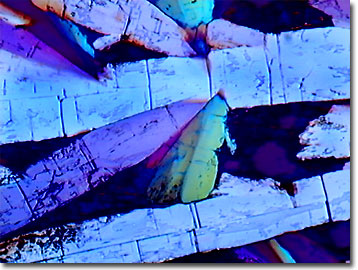Polarized Light Digital Image Gallery
Adenosine Triphosphate (ATP)
If the mitochondria are the "factories" of the cellular world, then adenosine triphosphate (ATP) is the chemical fuel that drives them. Adenosine triphosphate, the chemical energy currency of the plant and animal world, is required to for all the processes that keep organisms alive.

Energy is stored as a chemical bond between the endmost and central phosphate groups through a cycle that liberates adenosine diphosphate (ADP) and is released via enzyme action when needed. When an organism is resting, and energy is not such a limiting commodity, the reverse reaction takes place with the phosphate group being reattached to the ADP molecule utilizing energy derived from sunlight (in the case of photosynthesis) or from food (in cellular respiration). As with a series of batteries, ATP molecules act as chemical battery storage, storing rather than releasing reaction energy, at least until the organism requires it.
Adenosine triphosphate, a nucleotide, consists of a ribose (five-carbon sugar), a phosphate chain, and a purine base containing carbon and nitrogen atoms (adenine). In 1997, the Nobel Prize for Chemistry was shared by Dr. John Walker of Cambridge University, Dr. Paul Boyer from the University of California at Los Angeles (UCLA), and Danish scientist Dr. Jens Skou for their detailed description of the phosphorus cycle featured in the mitochondria of animal cells and the chloroplasts of plant cells. Life without adenosine triphosphate would not be possible, making it possibly the world's most important chemical substance.
Contributing Authors
Omar Alvarado, Thomas J. Fellers and Michael W. Davidson - National High Magnetic Field Laboratory, 1800 East Paul Dirac Dr., The Florida State University, Tallahassee, Florida, 32310.
BACK TO THE POLARIZED LIGHT IMAGE GALLERY
BACK TO THE DIGITAL IMAGE GALLERIES
Questions or comments? Send us an email.
© 1995-2025 by Michael W. Davidson and The Florida State University. All Rights Reserved. No images, graphics, software, scripts, or applets may be reproduced or used in any manner without permission from the copyright holders. Use of this website means you agree to all of the Legal Terms and Conditions set forth by the owners.
This website is maintained by our
Graphics & Web Programming Team
in collaboration with Optical Microscopy at the
National High Magnetic Field Laboratory.
Last Modification Friday, Nov 13, 2015 at 01:19 PM
Access Count Since September 17, 2002: 15768
Visit the website of our partner in introductory microscopy education:
|
|
